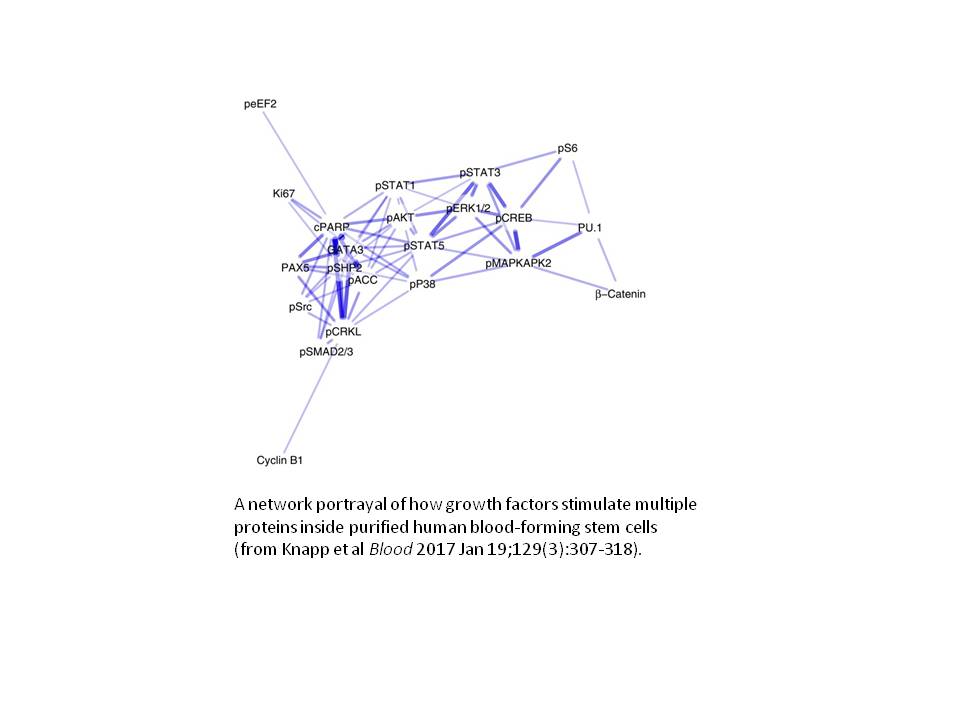 TFRI’s long-funded program project on human leukemia has made groundbreaking progress in the quest to expand human blood stem cells for therapeutic purposes. The team’s paper published in Blood (January 2017) reports the first use of a new technology to discover how growth factors activate signaling molecules inside these very rare human cells to control their survival, ability to divide and retention of their “stemness” properties.
TFRI’s long-funded program project on human leukemia has made groundbreaking progress in the quest to expand human blood stem cells for therapeutic purposes. The team’s paper published in Blood (January 2017) reports the first use of a new technology to discover how growth factors activate signaling molecules inside these very rare human cells to control their survival, ability to divide and retention of their “stemness” properties.
Growth factor combinations that would promote an expansion of human blood-forming stem cells (HSCs) outside of the body have been sought for many years by investigators around the world, but with limited success. One problem may be the historical assumption that the ability of blood stem cells to stay alive, divide and maintain their “stemness” would all be activated by the same mechanisms upon growth factor stimulation. This team has now shown this assumption is incorrect and have further demonstrated how different growth factors activate different mechanisms to produce different effects, which then must be co-ordinated to actually elicit all three desired effects (cells stay alive, divide to generate two daughter stem cells).
These studies were made possible through the use of a relatively new technology called mass cytometry. This technology that allows dozens of different types of molecules present inside cells (as well as on their cell surface) to be measured simultaneously, one cell at a time, even when they represent less than 0.1 per cent of all the cells being analyzed.
Specifically, the team found that growth factor-activated AKT and ß-catenin in human blood-forming stem cells are required to promote their survival and division. This information allowed the team to identify new agents that may be used to enhance or replace certain growth factors.
Expanding human blood stem cells for therapeutic purposes is one of the major goals of research in the blood-forming system and understanding how this process works is also fundamental to understanding how it goes wrong in human leukemia. This paper exemplifies the importance of developing, adapting and combining new technologies to gain insights into what makes important, but extremely rare, cells function properly.
Two of the paper’s principal authors, Drs. Connie Eaves and Keith Humphries, based at the BC Cancer Agency in Vancouver, have led one of the longest-running research programs funded by the Terry Fox Foundation. Previous stages of the program created the genetic tools to modify normal blood-forming stem cells so that they mimic leukemia cells, while the latest stage of the program uses those tools to create reproducible models of different types of different types of human leukemia.
Study: Distinct signaling programs control human hematopoietic stem cell survival and proliferation
Authors: David J. H. F. Knapp, Colin A. Hammond, Nima Aghaeepour, Paul H. Miller, Davide Pellacani, Philip A. Beer, Karen Sachs,Wenlian Qiao, WeiJia Wang, R. Keith Humphries, Guy Sauvageau, Peter W. Zandstra, Sean C. Bendall, Garry P. Nolan, Carl Hansen, and Connie J. Eaves.
Funding: This work was supported in part by a Terry Fox Foundation New Frontiers Program Project Grant
TFRI Links, Spring 2017